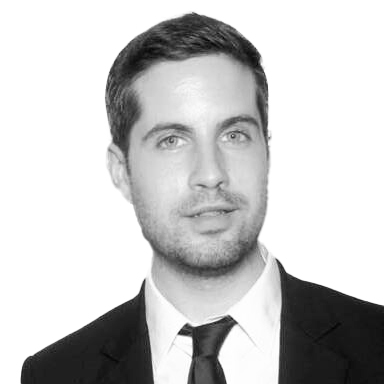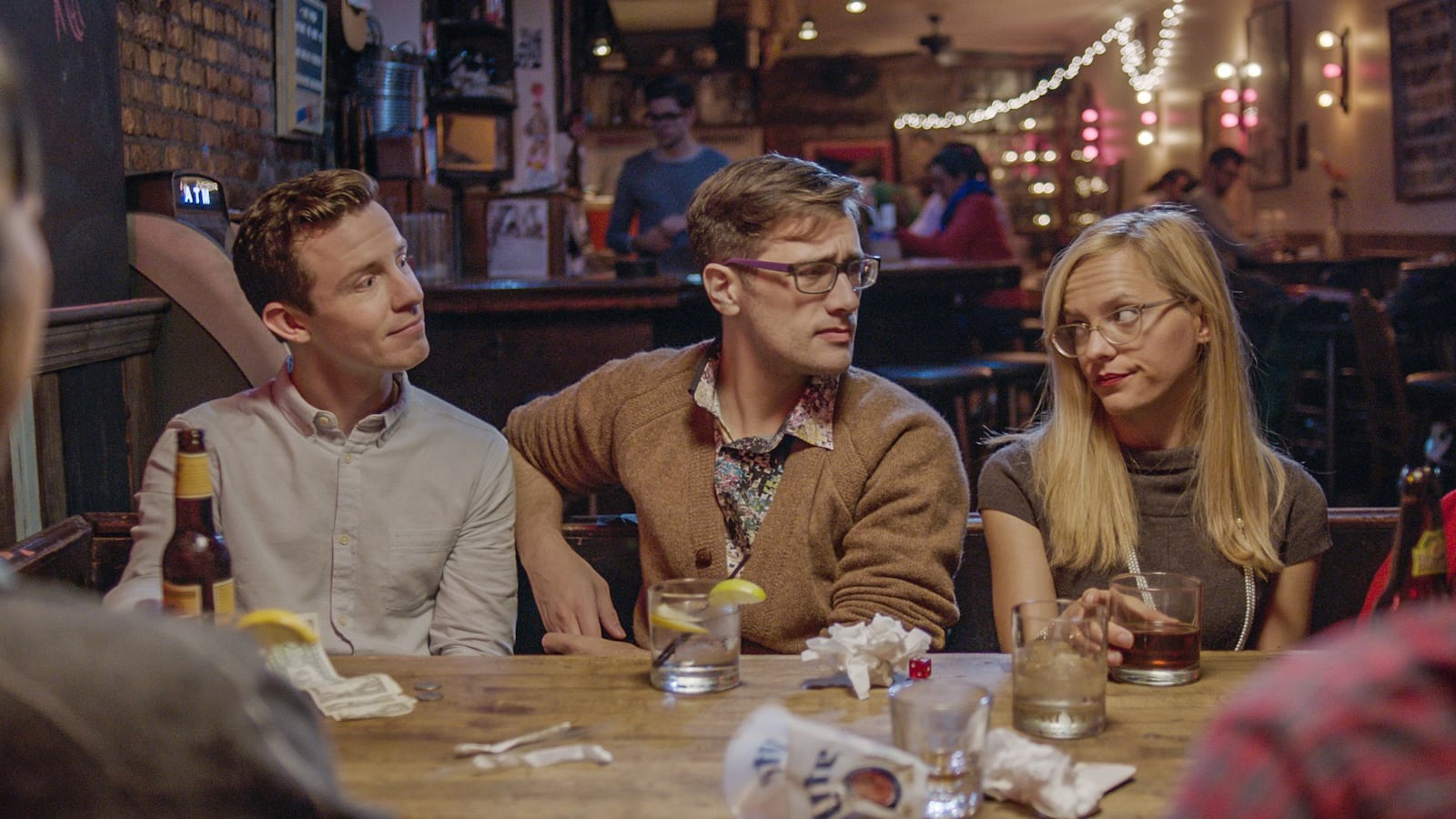By the time 2012 rolled around, television had played host to Will and Jack. Mitch and Cam were thoroughly modern. Gay characters had become so mainstream that a flashy new NBC sitcom was even dubbing them The New Normal.
But for all the talk of what was modern or normal, something essential was missing from the equation: gay characters that were, well, real. Enter The Outs, a seven-episode Little Web Series That Could and, at the time, one of the most realistic portrayals of gay life and, especially, gay dating. You know, the stuff that television wasn’t showing.
The first episode of the series was filmed, as has become famous to those “in” on The Outs, for a shoestring $500 budget over the course of 48 hours in the creators’ home turf of Crown Heights, Brooklyn. The DIY aesthetic and online distribution combined to make the portraits of the characters in the series seem all the more real and relatable.
Here were gay characters that weren’t stereotypes. Here were gay relationships that weren’t heteronormative, but authentic to a gay experience. In fits and bursts as Kickstarter and other crowdfunding campaigns would allow, The Outs eventually became a cult hit.
Word-of-mouth, especially in the gay community, built around the story of Mitchell and Jack, a gay couple “on the outs” and attempting to navigate a relationship as friends after they break up—poignantly charting the dangerous waters of such a friendship, as well as the loneliness.
It’s been three years since the last episode aired, and The Outs is back with its second season.
“It was sort of buried,” jokes Adam Goldman, who conceived the show and stars as Mitchell. “And then we dug it up. We Weekend at Bernies’d it.”
Helping Goldman prop up the corpse is Vimeo, who revived the show as part of the streaming service’s recent investment in original series. (Full disclosure: Vimeo and The Daily Beast are owned by the same company, IAC.)

It’s a godsend for the series’ original fans who, three years later, still find themselves starved for content that doesn’t marginalize gay culture to just sex or stereotypes. Instead it looks at how the reality of being a millennial—and all the angst, liberty, and dating app options it affords—ends up affecting romantic relationships and friendships.
In other words: actual gay life.
For Goldman and his collaborators Jay Gillepsie and Sasha Winters (who also plays Mitchell’s acerbic friend Oona), it meant crafting a new narrative for characters that they had long moved on from. In a bit of life imitating art, they thought they were done with the show, but it turned out their relationship wasn’t really over, either.
“At its best on this show, I always hope it feels like you’re hanging out with your friends,” he says. “And it’s always nice to see friends, even if you haven’t seen them in a while.”
***
The Outs has a bit of an infamous origin story, supposedly born out of a reaction Goldman had to watching The New Normal, 2012’s buzziest fall comedy because it was to be one of broadcast television’s first to center around the relationship of a gay couple. (A partnered, loving gay couple starting a family.)
Already distressed over the state of gays on TV—you’re either a stereotype sidekick or you fall squarely into a palatable picket-fence mold that you’re almost unrecognizable to a large swath of the gay community—Goldman vowed to watch The New Normal for as long as it took for them to make a lazy Madonna joke. He lasted 10 minutes.
He began writing The Outs shortly after, and while a lot of coverage of the show has presented its conception as a direct reaction to the Madonna joke, he says it was more in response to the general mood about the depiction of gay people on TV—people he didn’t see when he looked around him. Or, more importantly, when he looked at himself.
“It wasn’t a reaction,” he says. “But maybe there should be a reaction. Maybe people should be more upset than they are that there’s still such an embarrassing paucity of queer people on television.”
The Outs Season Two from Adam Goldman on Vimeo.
At a lunch on the day before The Outs’ second season is set to launch on Vimeo, Goldman, Winters, and Hunter Canning, who plays Mitchell’s ex Jack on the series, are trying desperately to name off gay characters that are currently on TV, searching for examples of complex, honest portrayals.
There’s the girls on Orange Is the New Black, of course, Goldman says. And there’s still the Modern Family guys. Andrew Rannells’s character on Girls is one. Jeff Perry’s on Scandal is another.
“On Mr. Robot there’s a gay character,” Canning offers. “Yeah, but he’s evil…” Winters responds.

“And uses gay sex as a tactic to get things,” Canning agrees, cringing. “On The Good Wife there’s Alicia’s brother…” Winters offers half-heartedly.
“They’re all sidekicks or evil,” Goldman says, the point made practically made for him.
“And we had Looking, but then Looking disappeared,” he says, referring to the short-lived HBO series about three gay friends in San Francisco that arrived with the weight of gay TV on its shoulders, but crumbled under the weight of thinkpieces and too much expectation. “The Outs wasn’t created as a reaction to that. But it was certainly along the lines of, ‘There needs to be more voices.’”
Serving a niche and underserved audience, of course, is what the Internet was essentially made for.
The Outs’ viewership wasn’t tallied in the millions, but the people who liked and who watched it were passionate about it. People who thought their stories weren’t being told on television or film rallied around it and told their friends about it. It was sought out by people looking to tap into something that, even if they couldn’t relate to, could give them hope that they might one day relate to.
In the early days of web series, The Outs was hailed alongside High Maintenance as original content that rivaled the quality of something you’d find on a traditional TV outlet. In the years since, of course, streaming services have become so respected that watching original content on their platforms has become its own new normal.
It’s the perfect time, then, for The Outs to make its comeback. Particularly since, even though no new episodes have been made in three years, the show’s impact never waned.
Goldman, Winters, and Canning go practically breathless recounting emails, letters, and, now, even Instagram direct messages from people the show has reached—and that’s not to mention the response they get when they walk into a New York gay bar.
There’s the closeted teenager from a small town who thanked them for showing him that there’s a life to look forward to when he finally can get out of Dodge. One fan in Europe wrote to Canning explaining that he translated an episode into Italian so he could it show to his parents when he comes out to them and be able to say, “This is what my life is like. It’s not what you think. This is what it could be like.”

“We’re all New York actors,” Canning says. “We’re auditioning. We’re going in for one line in a commercial all the time. It’s a very different experience to be like, ‘What a great Slurpee!’ to then have this show that people all around the world say is changing things for them.”
If the nuance and spectrum of representation of the gay community hasn’t gotten richer, let alone that of the gay-and-single millennial male, in the three years between seasons of The Outs, one thing does seem to be changing, and it’s encouraging.
The idea that a show like this is “for gays only” is becoming more antiquated. A “straight” audience is becoming more engaged in content like The Outs, marking a turning point where, perhaps, they’re able to empathize and relate to a romantic gay relationship.
And not just a relationship like Mitch and Cam in Modern Family, which resembles a coupling in a very traditional and, in some ways, neutered sense. But one like the characters in The Outs have, where there’s sex and messiness and loneliness and relationships that are undefined. Like in real life.
“Whether straight people want to acknowledge or not, the lines between straight dating and gay dating in a metropolitan city are pretty blurry,” Goldman says. “Particularly the way that Tinder has proliferated. Straight people are dating the way that gay men have been dating for a few years now, on apps. It’s a similar landscape.”
“I’m a straight person and one of my favorite romances is Weekend,” Winters says, referencing the 2011 film about a gay couple’s whirlwind romance. “I thought it was beautiful.”
“It’s also funny because we’re people,” Goldman continues. “We know it can be done because we’ve been enjoying straight romances forever and switching pronouns in songs and imagining. It’s just about getting people around to the point of understanding that what’s being talked about is not fundamentally gay. It’s a relationship.”
In fact, so much of the appeal of The Outs, and much of its originality, is owed to things that, as Goldman says, has nothing to do with being gay.
While the lives of wayward twentysomething millennials are, at this point, richly explored on television (Girls, Broad City), adults in their 30s are, generally, only portrayed within the conversation of “having it all”: a personal and professional life that is, for lack of a better word, “together.”

The Outs explores what it’s like to be 30, have a job, date, and not be the “mess” millennials they are often thought to be, but still have elements of life that need figuring out. They still have roommates. They don’t own property. They’re not married and don’t have children. They have their lives “together.” But also they don’t.
“I think this season is less about being aimless,” Goldman says. “But I also think you grow out of the notion that your life can ever be together.”
Talking about Jack’s evolution from Season One to Season Two, Canning says, “I think before he was asking himself, ‘Can I even survive here?’ Now it’s like, ‘Can I enjoy surviving here?’ That’s the next step.”
Winters brings up the phenomenon where people would move to New York City after seeing the so-called “mess” of the characters in Girls and even the first season of The Outs, despite the fact that not much of their lives was aspirational.
“When you’re young you want to have a fucked-up life for a little while,” she says. “You just want anything to happen to you.”
Season Two of The Outs evolves that notion. Things and relationships are still pretty fucked up. Just…less so.
“The tagline for the first season was, ‘Just because it’s over doesn’t mean you’re over it,’” Goldman says. “I was thinking if we did one for this season, it would be, ‘Just because you’re over it doesn’t mean that it’s over.’”
Before we part ways, I ask if it’s frustrating that, given all we had just discussed about resonant aspects of the series that have nothing to do with sexuality, that the conversation surrounding The Outs undoubtedly turns to its gayness.
“Yes and no—I don’t want to shy away from it being as gay as it is,” Goldman says prompting a laugh from Canning: “That should be the title of your next show, As Gay As It Is.”
After a chuckle, Goldman takes a beat. “Again, it’s embarrassing to be thinking that making a show about gay people is a political act in 2016. But it is.”






